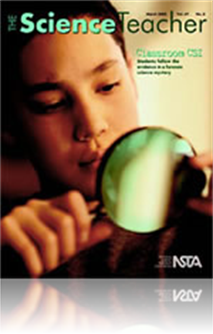All Resources
Journal Article
This paper describes how to use collaborative groups as a teaching strategy in a 200-student introductory astronomy class for nonscience majors. The authors present a brief rationale for this approach and then describe the implementation details and ...
Journal Article
Putting Public Television to Work for You
Public television programs such as ZOOM, A Science Odyssey, and NOVA can be a great way to enhance the science curriculum. Suggestions for using these programs in the classroom and accessing supplemental materials, teacher's guides, and websites are ...
Journal Article
Teaching the New Taxonomy: Getting up to speed on recent developments in taxonomy
Not only is today's taxonomy very different than we learned in school, but it is also different than the system in most textbooks. These exercises are a good way to encourage students to think about the basic assumption of modern taxonomy—that char...
Journal Article
The Science Behind a NASA Poster
Teachers can take advantage of free space-education materials from NASA. Posters provide information about NASA, space science, and careers in science, as well as lessons plans and activities. Ordering information is provided along with links to webs...
Journal Article
Teachers in this school district soon realized they were on different paths in science literacy and one district had no science standards. This article describes their journey to identify science standards and ultimately develop a cohesive, well-thou...
Journal Article
Research and Teaching: Technophobia and Teaching Technology Rich Freshman Science Courses
Qualitative research methods were used to document the experiences of six technophobic students as they progressed through a technology-rich anatomy and physiology course. Data collected were analyzed and condensed into common themes. Simple recommen...
Journal Article
In this innovative method of testing in general and organic chemistry, students receive prepared, randomized cards with a portion of a question on them. The students must then use the cards to complete and answer specific test questions. This techniq...
Journal Article
Lights, Camera, and the Action of Science
In this day and age, students spend much of their time glued to their television sets. This is understandable as many of today’s programs are action packed and narrative in nature, and thus attractive to students. When not at home, money is spent a...
Journal Article
The authors suggest several ways to catch and hold student interest in physics. One excellent method is to use the television series Star Trek to extend the science curriculum. The beauty of this program is that the writers based their creations on k...
Journal Article
Snow Globe Science: Students learn solution chemistry through an open-ended lab investigation
Allowing students to experiment to make a product such as a snow globe encourages the development of problem-solving skills, and students learn the concepts behind solution chemistry by determining the best combination of materials for the snow globe...
Journal Article
Commentary: Our Apartheid—The Imperative of Multiculturalism in Science Education
An opinion piece about the lack of diversity in science. Courses, curricula, and classrooms must be more accessible and more friendly to include "science for all."...
Journal Article
Are your science textbooks still including the prototype for the space shuttle, Enterprise? If so, follow the authors’ favorite ways of incorporating different media into the classroom provided in this article. Cartoons, videos, DVDs, newspapers, a...
Journal Article
Countering Gender Bias in the Media
This inquiry-based activity raises student awareness of the inequity that exists in the way the media portrays the contributions of men and women. Students look at a variety of images of men and women engaged in different actitivities, and then make ...
Journal Article
Spanish-speaking young readers are eager to explore and understand the world. This selection of well written trade books in Spanish will satisfy young Spanish speakers' quest for knowledge....






